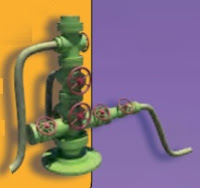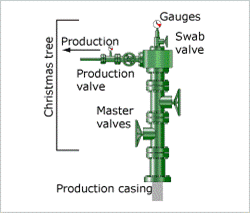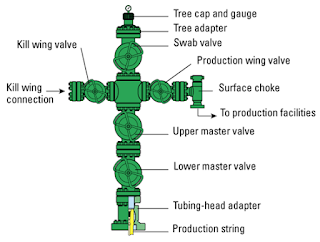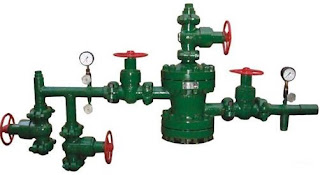CHRISTMAS TREE (IN OIL INDUSTRY):
The energy sources of the world are either renewable or non-renewable energy sources. Petroleum is a non-renewable energy source and during extraction, crude oil found underground is usually mixed with water, sand, salt and natural gas. As it is extracted, the pressure of these different substances must be kept at just the right levels. This is done by turning valves on and off at the surface level. These valves are often green in colour and the small dials are red, much like the pine trees decorated at Christmas time, this assembly is often referred to as a Christmas tree.
The energy sources of the world are either renewable or non-renewable energy sources. Petroleum is a non-renewable energy source and during extraction, crude oil found underground is usually mixed with water, sand, salt and natural gas. As it is extracted, the pressure of these different substances must be kept at just the right levels. This is done by turning valves on and off at the surface level. These valves are often green in colour and the small dials are red, much like the pine trees decorated at Christmas time, this assembly is often referred to as a Christmas tree.

The words ‘Christmas Tree’ and ‘Wellhead’ are used interchangeably at times; however, a wellhead and Christmas tree are entirely seperate pieces of equipment. A wellhead must be present in order to utilize a Christmas tree and is used without a Christmas tree during drilling operations. Producing surface wells that require pumps (pump jacks, nodding donkeys, etc.) frequently do not utilize any tree due to no pressure containment requirement.
Tree complexity has increased over the last few decades. They are frequently manufactured from blocks of steel containing multiple valves rather than made from multiple flanged valves.
The primary function of a tree is to control the flow into or out of the well, usually oil or gas. A tree often provides numerous additional functions including chemical injection points, well intervention means, pressure relief means (such as annulus vent), tree and well monitoring points (such as pressure, temperature, corrosion, erosion, sand detection, flow rate, flow composition, valve and choke position feedback, connection points for devices such as Down Hole Pressure And Temperature Transducer (DHPT).
In oil and gas extraction, a Christmas tree, or
‘tree’ (not ‘wellhead’ as sometimes incorrectly mentioned), is an assembly of
valves, spools and fittings used for oil wells, gas wells, water disposal
wells, water injection wells, gas injection wells, condensate wells and other
types of wells. It was named as Christmas tree due to its crude resemblance to
this decorated tree.
Christmas trees are used in both subsea and
surface wells. Commonly, there are two types of tree – subsea tree, and surface
tree.
 Note
that a Christmas tree isn’t the
same equipment as wellhead. They are different separate pieces of equipment.
The Christmas tree is installed on top of wellhead. A well head can be used
without a Christmas tree during drilling operations. Wells being produced with
the rod pumps (nodding donkeys, pump jacks, etc.) frequently don’t utilize any
tree due to no pressure-containment requirement.
Note
that a Christmas tree isn’t the
same equipment as wellhead. They are different separate pieces of equipment.
The Christmas tree is installed on top of wellhead. A well head can be used
without a Christmas tree during drilling operations. Wells being produced with
the rod pumps (nodding donkeys, pump jacks, etc.) frequently don’t utilize any
tree due to no pressure-containment requirement.THE STRUCTURE OF A CHRISTMAS TREE:
 Two lower valves are called master valves
(upper and lower respectively) as they lie in the flow path that well fluids
must take to come to surface. Lower master valve is often manually operated,
while the upper master valve is normally hydraulically actuated.
Two lower valves are called master valves
(upper and lower respectively) as they lie in the flow path that well fluids
must take to come to surface. Lower master valve is often manually operated,
while the upper master valve is normally hydraulically actuated.
• The right hand valve is often known as
production wing valve or flow wing valve, because it is in the flow path that
the hydrocarbons take to production facilities.
 • The left hand valve is called the kill wing
valve. It is mainly used for injection of fluids like corrosion inhibitors or
methanol to avert hydrate formation.
• The left hand valve is called the kill wing
valve. It is mainly used for injection of fluids like corrosion inhibitors or
methanol to avert hydrate formation.
• The valve at the top is known as the swab
valve and lies in the path used for well interventions such as wireline and
coiled tubing.
• A choke is a device either stationary or
adjustable. It is used to control the gas flow (also, volume), or create downstream
pressure (also, back pressure).
Shown already on this
Christmas Tree Diagram, there are five valves. The Kill Wing valve, the Swab
valve, the production wing valve, the upper master valve and lower master
valve. When the operator, well, and facilities are ready to produce and receive
oil or gas, valves are opened and the release of the formation fluids is allowed
to flow into and through a pipeline. It is important to understand where these
valves are located and what role they play in getting gas from the well bore to
the customer.
RECOMMENDED STANDARDS FOR CHRISTMAS TREE:
API 6A: Specification for Wellhead and Christmas Tree Equipment .
(You can contact me on how to get a copy if you need it.)
CHRISTMAS TREE PARTS DEFINED:
•The two lower valves are
called the master valves (upper and lower respectively) because they lie in the
flow path, which well fluids must take to get to surface.
•The lower master valve will
normally be manually operated, while the upper master valve is often
hydraulically actuated.
•Hydraulic tree wing valves
are usually built to be fail safe closed, meaning they require active hydraulic
pressure to stay open.
•The right hand valve is often
called the flow wing valve or the production wing valve, because it is in the
flow path the hydrocarbons take to production facilities.
•The left hand valve is often
called the kill wing valve. It is primarily used for injection of fluids such
as corrosion inhibitors or methanol to prevent hydrate formation.
•The valve at the top is
called the swab valve and lies in the path used for well interventions like
wireline and coiled tubing.
A ‘Choke’ is a device, either
stationary or adjustable, used to:
•control
the gas flow, also known as volume
•or create
downstream pressure, also known as back pressure
FUNCTION OF A CHRISTMS
TREE:
The main function of a Christmas tree is to control the oil
and gas flow out of the well. It may also be used to control the injection of
gas or water into the non-producing well so as to improve production rates of
oil from other wells. When the well and facilities are all set to produce and
receive oil or gas, the tree valves are opened and the formation fluids are
enabled to go through a flow line. Then a processing facility, storage depot
and/ or other pipelines lead to a refinery or distribution center for gas. The
flow lines on subsea wells often lead to a fixed or floating production
platform or to a storage ship, known as floating processing unit (FPU), a
floating storage offloading vessel (FSO), a floating production, storage and
offloading vessel (FPSO).
A Christmas tress often provides a number of additional functions, including well
intervention means, pressure relief means, chemical injection points,
monitoring points (pressure, temperature, erosion, corrosion, sand detection,
flow composition, flow rate, valve, choke position feedback, etc.), and
connection points for such devices as down hole pressure and temperature
transducers (DHPT).
A tree may also be used to
control the injection of gas or water injection application on a producing or
non-producing well in order to sustain economic "production" volumes
of gas from other well(s) in the area (field); although injection of chemicals
or alcohols or oil distillates to prevent and or solve production problems (such
as blockages) may be used in producing wells.
The control system attached to
the tree controls the downhole safety valve (SCSSV, DHSV, SSSV) while the tree
acts as an attachment and conduit means of the control system to the downhole
safety valve.
Onshore drilling is used for underground oil reservoirs anywhere on dry
land. Drilling on land generally requires relatively low investments and entails
fewer risks. Once the crude oil is extracted from the ground, it is taken to
gathering centres where the water, sand and salt are removed.
While there, natural gas is also separated from the crude oil and then sent
to a booster station. The oil is then
pumped to storage tanks before being sent to either a refinery for proper
processing or to oil tankers for shipment elsewhere.
Offshore drilling is used to extract oil deposits buried under the ocean
floor. Offshore drilling rigs are installed,
operated and serviced on large platforms built out in the ocean. These platforms can either float or sit on
tall ‘legs’ that touch the seabed. In this way, the offshore rig is able to
remain stable and resist waves, wind and, in colder regions, floating chunks of
ice. Due to its difficulty, offshore drilling consumes more than 65% of planned
investments even before oil is extracted, increasing the risk of financial
losses, especially if wells come up dry!
Exploration activities in finding underground oil
reservoirs and drilling wells are risky, complicated and expensive activities. The cost of drilling an exploratory oil well
can be anything from $1 million to $35 million.
Building and developing a well depends on many
factors: the location of the potential
oil field (if it is on land or under water), the size of the oil field, the
amount of information that is already available and the type of rocks found
underground.
Many oil fields are found in hard-to-reach areas on
land or below deep ocean water. New
technology is helping oil companies reach these oil fields and increase the
amount of oil extracted from the ground.
But in order to pay for new technology, hundreds of millions of dollars in
investments are needed. The average amount of time needed to discover, extract
and market oil is between 3 to 10 years. But oil explorers also need time to
raise the necessary money in order to deal with all the technical challenges.
Much of the time needed depends on the location of
the oil field. An offshore oil field in deep water can take much longer to
discover and test, especially when the sea bottom is thousands of metres below
the surface.
 The downstream sector is the part of the oil
industry involved with purifying crude oil and refining it into different
products. It also involves the transportation and marketing of crude oil and
its products. The process through which
crude oil is purified and treated to remove unusable substances is called
REFINING. This process is also used to separate oil into different usable petroleum
products. All this takes place in an oil refinery. All refineries perform three
basic functions: separation, conversion and treatment.
The downstream sector is the part of the oil
industry involved with purifying crude oil and refining it into different
products. It also involves the transportation and marketing of crude oil and
its products. The process through which
crude oil is purified and treated to remove unusable substances is called
REFINING. This process is also used to separate oil into different usable petroleum
products. All this takes place in an oil refinery. All refineries perform three
basic functions: separation, conversion and treatment.
Refining methods are constantly being improved. A variety of complex operations are now used
which have improved their output. Refineries today turn more than half of every
barrel of crude oil into gasoline. One barrel is equal to 159 litres (42 US
gallons). This is a big advance from
only 70 years ago when only 41 litres (11 gallons) of gasoline were produced
from each barrel of crude.
Oil pipelines are made from steel. They usually have an inner diameter of about
10 to 120 cm (about 4 to 48 inches) and can run for hundreds or thousands of
kilometres. Advances in technology are
constantly improving the size and strength of these pipelines. Although
pipelines are less flexible than other forms of transportation, they are the
safest, most efficient and most economical way to move oil. All large modern oil fields have direct
connections to major pipelines. Without
these pipelines, it would be impossible for oil and oil products to reach consumers.
In conclusion, it is noteworthy that the body that
helps to co-ordinate the policies and ensure best practices in the oil industry
is Organization of the Petroleum Exporting Countries (OPEC), and it was
introduced at Baghdad conference held on September 10–14, 1960. The five Founder
Members were: Iran, Iraq, Kuwait, Saudi Arabia and Venezuela. The OPEC logo is
the recognizable symbol of the Organization, and was the result of an
international design competition held in 1969. An Austrian designer, Gertrude
Svoboda, won the competition with her design, which combined the different
letters of the Organization’s name in a rounded design.



No comments:
Post a Comment